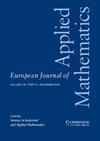孔隙尺度污染物分布对多孔介质活性去污的影响
IF 1.1
4区 数学
Q1 MATHEMATICS, APPLIED
引用次数: 0
摘要
被有害化学试剂污染的多孔材料通常通过将清洁剂溶液应用于表面并使清洁剂与多孔材料反应,中和试剂来净化。试剂和清洁剂通常是不混溶的流体,因此,如果多孔材料最初被试剂饱和,则随着在流体之间的该界面处发生的去污反应而产生反应前沿。我们研究了孔隙空间内不同初始药剂配置对去污过程的影响。具体而言,我们将最初被药剂饱和的材料的去污与最初药剂仅覆盖孔隙壁的情况(称为“壁上药剂”情况)进行了比较。在之前的工作中(Luckins等人,《欧洲应用数学杂志》,31(5):782–8052020),我们推导了这两种去污场景的均质模型,并在本文中探索了这两个模型的解决方案。我们发现,对于相同初始体积的试剂,与最初饱和的情况相比,壁上试剂的去污时间通常要快得多,因为可以发生反应的表面积更大。然而,对于足够深的污染物溢出或足够慢的反应速率,在墙上的药剂场景中的去污可能会较慢。我们还表明,在初始药剂泄漏较深的稀释清洁剂的极限下,壁上药剂模型表现出类似于Stefan问题的行为,该问题的形式与初始饱和模型中出现的问题相同。去污时间显示随着所施加的清洁剂浓度和化学反应的速率而减少。然而,增加清洁剂浓度也会导致去污效率降低,浪费的清洁剂化学物质的量也会增加。本文章由计算机程序翻译,如有差异,请以英文原文为准。
The effect of pore-scale contaminant distribution on the reactive decontamination of porous media
A porous material that has been contaminated with a hazardous chemical agent is typically decontaminated by applying a cleanser solution to the surface and allowing the cleanser to react into the porous material, neutralising the agent. The agent and cleanser are often immiscible fluids and so, if the porous material is initially saturated with agent, a reaction front develops with the decontamination reaction occurring at this interface between the fluids. We investigate the effect of different initial agent configurations within the pore space on the decontamination process. Specifically, we compare the decontamination of a material initially saturated by the agent with the situation when, initially, the agent only coats the walls of the pores (referred to as the ‘agent-on-walls’ case). In previous work (Luckins et al., European Journal of Applied Mathematics, 31(5):782–805, 2020), we derived homogenised models for both of these decontamination scenarios, and in this paper we explore the solutions of these two models. We find that, for an identical initial volume of agent, the decontamination time is generally much faster for the agent-on-walls case compared with the initially saturated case, since the surface area on which the reaction can occur is greater. However for sufficiently deep spills of contaminant, or sufficiently slow reaction rates, decontamination in the agent-on-walls scenario can be slower. We also show that, in the limit of a dilute cleanser with a deep initial agent spill, the agent-on-walls model exhibits behaviour akin to a Stefan problem of the same form as that arising in the initially saturated model. The decontamination time is shown to decrease with both the applied cleanser concentration and the rate of the chemical reaction. However, increasing the cleanser concentration is also shown to result in lower decontamination efficiency, with an increase in the amount of cleanser chemical that is wasted.
求助全文
通过发布文献求助,成功后即可免费获取论文全文。
去求助
来源期刊
CiteScore
4.70
自引率
0.00%
发文量
31
审稿时长
>12 weeks
期刊介绍:
Since 2008 EJAM surveys have been expanded to cover Applied and Industrial Mathematics. Coverage of the journal has been strengthened in probabilistic applications, while still focusing on those areas of applied mathematics inspired by real-world applications, and at the same time fostering the development of theoretical methods with a broad range of applicability. Survey papers contain reviews of emerging areas of mathematics, either in core areas or with relevance to users in industry and other disciplines. Research papers may be in any area of applied mathematics, with special emphasis on new mathematical ideas, relevant to modelling and analysis in modern science and technology, and the development of interesting mathematical methods of wide applicability.

 求助内容:
求助内容: 应助结果提醒方式:
应助结果提醒方式:


